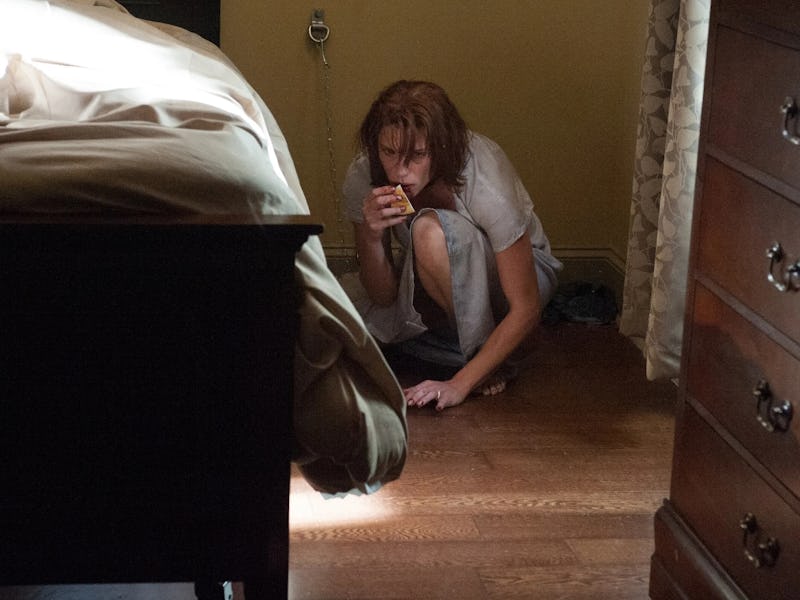10 Years Ago, Mike Flanagan Established His Horror Blueprint
The real horror lies in memory. But also in the spooky mirror.

Mike Flanagan is a reigning master of familial horror. Between movies like Doctor Sleep and series like The Haunting of Hill House, his work continually explores ghosts and traumas passed down through generations. He does the same thing in his devastating movie Oculus; though often overshadowed by his later work, Flanagan’s second feature laid out the blueprint for the familial horror that serves as his trademark, cementing him as a modern auteur who can emotionally devastate audiences just as easily as terrify them.
Flanagan recently celebrated Oculus’ 10-year anniversary with a screening at The Overlook Film Festival. During a Q&A with Fangoria editor-in-chief Phil Nobile Jr., Flanagan addressed his fascination with familial horror: “I had a very balanced and safe childhood, believe it or not, and so to me, the idea of the family falling apart and home being kind of a place that is fundamentally dangerous has always been very scary.”
Flanagan’s work often plays with ambiguity, raising questions about how much responsibility the supernatural forces in his stories actually bear for his characters’ woes. In the Flanaverse, evil is allowed entry through cracks in the family’s defenses. Trauma, addiction, mental illness, and abuse invite ghosts and demons in, not the other way around.
In Oculus, Alan Russell (Rory Cochrane) is a software engineer moving up in the world. He gets a big house with ostentatious furniture to reflect that upward mobility, and the large, expensive mirror Alan orders for his office — without warning his wife, Marie, about the expense (Katee Sackhoff) beforehand — is no ordinary antique. Unknown to them, it’s the haunted Lasser Glass, an evil object that brings misfortune to anyone who encounters it. Marie already has reservations about their life makeover, wondering aloud whether Alan’s remodeling plans include getting a new, improved wife. The Glass preys on its owners’ weaknesses, and the growing cracks in Alan and Marie’s marriage provide ample room for it to wedge its malign influence into their lives.
Oculus adopts a narrative approach that characterizes much of Flanagan’s work. Dual timelines follow Alan and Marie’s children, Kaylie and Tim, as they deal with the events that lead to the demise of their parents, and the fallout when no one else believes the Lasser Glass is responsible for those events. Karen Gillan and Brenton Thwaites play the siblings as adults, while Annalise Basso and Garrett Ryan Ewald play the pair as children, though Flanagan deliberately blurs the distinctions between the two timelines. There’s no neat and tidy separation between adulthood and childhood. No matter how big you get or how settled you are with a job, house, or family, the scared 10-year-old you used to be never goes away.
Especially if your family buys a weird mirror.
Blurring time to paint a complete portrait of a person’s identity is a technique Flanagan returns to often in his work. Dan Torrance sits in the boiler room of the Overlook Hotel in Doctor Sleep and then appears as his younger self while his mother smiles at him. Young Nell Crain lies on a sofa in The Haunting of Hill House and sees a ghost she calls the Bent-Neck Lady floating above her, not realizing it’s a vision of her adult self. There, Flanagan even uses the same camera technique that he did in Oculus.
When we see Nell lying on the sofa, the camera is on a traditional axis, with the sofa lying horizontally across the screen. When she sees the Bent-Neck Lady, however, the camera rotates 90 degrees counterclockwise so that both Nells appear to be standing and looking at each other. They’re separated by decades of tragedy, yet they’re only a few feet apart. Flanagan uses the same movement twice in Oculus: first during a love scene between Alan and Marie, and later when Kaylie wakes to the sound of her parents arguing. But Flanagan inverts the motion — while the love scene begins on the standard horizontal view and rotates to vertical, Kaylie waking up begins on a vertical view and rotates to the standard horizontal. By reversing the orientations in these shots of domestic harmony and strife, Flanagan highlights how the Russell family has been shifted by the Lasser Glass’ influence.
The breakdown of home and family, where you’re supposed to be safest, is terrifying. Few horror filmmakers understand this as keenly, or explore it as painfully, as Flanagan. As children, Tim and Kaylie promise each other to avenge their beloved parents and destroy the Glass, declaring, “When we’re big and we’re strong, we’ll make this right.” But their promise is in vain, because they haven’t yet grown to understand that you cannot simply outmuscle trauma. It’s a theme Flanagan explores time and again in his work, and Oculus is where he sets his heartbreaking blueprint.